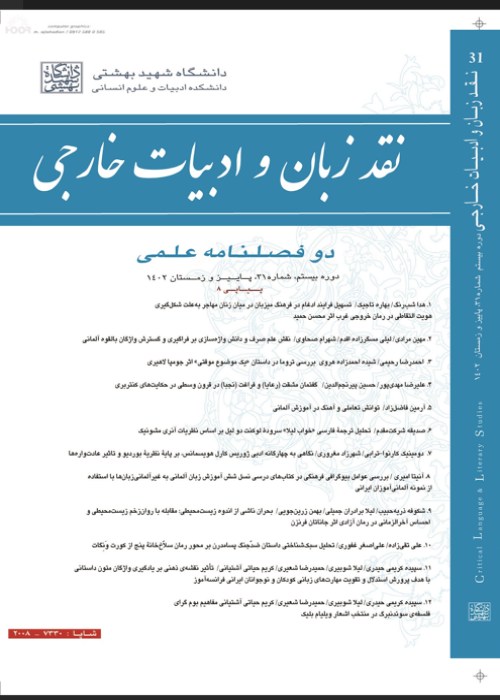The Eye/I of the Storm: The Hollowness of Identity and Knowledge of Posthuman Subjects in Cyberpunk Fiction
Author(s):
Article Type:
Research/Original Article (دارای رتبه معتبر)
Abstract:
Introduction
Cyberpunk is one of the latest genres in the development of science fiction. In it, characters deal with various cybernetic and technological advancements with futuristic affinities. In this genre, characters experience such futuristic advancements through a series of images and surface values.
Background Studies
Alongside Garfield Benjamin’s The Cyborg Subject: Reality, Consciousness and Parallax, and William Haney’s Cyberculture, Cyborgs and Science Fiction: Consciousness and the Posthuman as the two key critical sources of the study, itconsiders David Bell’s Cyberculture Theorists, Larry McCaffery’s Storming the Reality Studio and Graham Murphy’s Beyond Cyberpunk so that the position of the utilized critical premises within the historical development of cyberpunk fiction can be determined. Next, to these sources which have critically discussed cyberpunk fiction, the study also considers sources such as Adam Robert’s Science Fiction and Larry McCaffery’s Across the Wounded Galaxies so that cyberpunk fiction’s position in the overall development of science fiction as a literary genre can be understood. After reviewing the critical position of cyberpunk fictionin the development of science fiction, the study searches for the sources which have directly
discussed cyberpunk fiction as a genre in itself. In this search, Dani Cavallero’s Cyberpunk
and Cyberculture: Science Fiction and the Work of William Gibson and Nader Elhefnawy’s
Cyberpunk,
Steampunk and Wizardry
Science Fiction since 1980 are two of the sources which have been engaged directly with the genre and its various aspects.
Methodology and Argument
Through reviewing works of key writers in the genre - including Bruce Sterling’s Schismatrix Plus (1985), Greg Egan’s Permutation City (1994), William Gibson’s Idoru (1996), and Richard Morgan’s Altered Carbon (2002) – the present study asks what the status of characters’ knowledge and identity is in the cyberpunk world. This general research question is parsed into two minor questions, creating the final structure of the article: First, what are the repercussions for citizens who are involved with superficial values both in the physical and virtual aspects of the cyberpunk world? Second, can citizens gain any knowledge in regards to their identity status in the cyberpunk world? In answering the first question, the key features of the posthuman identity of cyberpunk citizens are enumerated. Being incapable of referring to a fixed identity center, being incapable of acquiring redemption or absolution, identity multiplicities, and knowledge through identity as the only means of knowledge acquisition are the four features of the posthuman identity of cyberpunk citizens. In answering the second question, the features of knowledge through identity as the only means of acquiring knowledge are enumerated. Being in initial deterrence and oblivion regardingthe hollowness of identity, partial and temporary realization of identity hollowness, remaining
fluid among identity multiplicities, strengthening of a non-nihilistic and non-religious urge to
return to nothingness, embracing one’s basest and vulnerable identity aspects, and embracing
the partial and temporary nature of all knowledge acquisition processes are the six features
which knowledge through identity has in the cyberpunk world.
Conclusion
Through the utilization of ideas of Garfield Benjamin and William Haney, two well-known critics in Cyberculture and Posthuman/Cyborg Identity, the study concludes that cyberpunk citizens’ knowledge and definition from their identities are shattered and nonessential. Cyberpunk citizens have fluid movement between their various identities and have a simultaneous sense of belonging and non-belonging to all of them. All these identities are formed around the hollowness and emptiness of the citizens’ identity core, which is the only essence of posthuman subjects. These identities only create deterrence in citizens’ paths to realize their emptiness. Only a few of the citizens manage to understand temporarily their identity hollowness and their fluidity among their exchangeable identities. Language:
Persian
Published:
Critical Language & Literary Studies, Volume:16 Issue: 22, 2019
Pages:
77 to 98
magiran.com/p2008806
دانلود و مطالعه متن این مقاله با یکی از روشهای زیر امکان پذیر است:
اشتراک شخصی
با عضویت و پرداخت آنلاین حق اشتراک یکساله به مبلغ 1,390,000ريال میتوانید 70 عنوان مطلب دانلود کنید!
اشتراک سازمانی
به کتابخانه دانشگاه یا محل کار خود پیشنهاد کنید تا اشتراک سازمانی این پایگاه را برای دسترسی نامحدود همه کاربران به متن مطالب تهیه نمایند!
توجه!
- حق عضویت دریافتی صرف حمایت از نشریات عضو و نگهداری، تکمیل و توسعه مگیران میشود.
- پرداخت حق اشتراک و دانلود مقالات اجازه بازنشر آن در سایر رسانههای چاپی و دیجیتال را به کاربر نمیدهد.
In order to view content subscription is required
Personal subscription
Subscribe magiran.com for 70 € euros via PayPal and download 70 articles during a year.
Organization subscription
Please contact us to subscribe your university or library for unlimited access!


